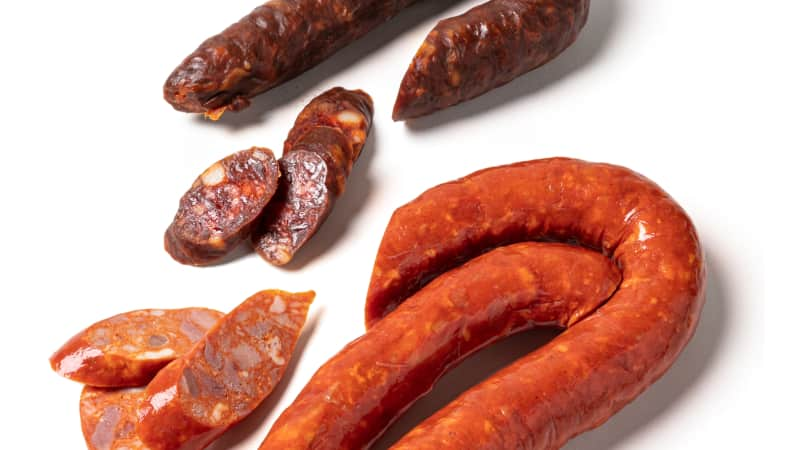Portuguese linguica (lin-GWEE-sah) and chouriço (sho-REE-zoh) and Spanish chorizo (chorr-EE-zoh) are all cured and smoked sausages from the Iberian Peninsula. But they seem to sow confusion—there’s even a common misconception that chouriço and chorizo are different names for the same product. The confusion is understandable, since they share similar flavorings, and there are no official standards to help define them. Each is fully cooked when smoked (unlike Mexican chorizo, which is raw), and seasoned with sweet, hot, and/or smoked paprika; garlic; black pepper; and sometimes wine or vinegar. But their exact blend of seasonings, along with other variables such as the meat-to-fat ratio and how finely or coarsely the meat is ground, can differ from region to region, producer to producer, and family to family—making it hard to pin down clear-cut distinctions.
What’s the Difference Between Linguica, Chouriço, and Spanish Chorizo?
Published Apr. 19, 2022.

Here are some of the differences that often—but not always— crop up in the sausages.
Sign up for the Cook's Insider newsletter
The latest recipes, tips, and tricks, plus behind-the-scenes stories from the Cook's Illustrated team.
Linguica
Though lingua is the Portuguese word for tongue, this link does not contain tongue, as is often reported. Its one consistent difference from chouriço may be that linguica is often stuffed into pig casing, so that it has a thinner diameter (chouriço is frequently made with beef casing). Its smoky, robust flavors permeate the classic speciality of the Algarve region amêijoas na cataplana, featuring clams cooked in a tomato-based broth, and I call for it in my own riff on this dish. It’s also an essential ingredient in the country’s famously over-the-top sandwich francesinha, or “little Frenchie,” in which linguica and slices of ham and roast beef are piled on bread, smothered with melted cheese, and doused with a tomato-and-beer sauce.
Cataplana (Portuguese Seafood Stew)
Our cataplana captures the treasures of the Algarve region—abundant fresh seafood, smoky cured meat, vibrant paprika—in a rich, ruddy broth.Chouriço
Other than often being fatter than linguica when stuffed into beef casing (or the pig's large intestine), chouriço’s differences from linguica are slight. Like its cousin, it can be mild or spicy and shares the same smoky, garlicky flavors that are also often accented by the tang of red wine. Even so, chouriço has the reputation of being the more versatile of the two. In Portugal, it’s served grilled, broiled, and roasted; it flavors a multitude of stews and soups, including caldo verde; it can be fried with eggs, roasted with potatoes, or cooked with rice. In the flamboyant dish chouriço à bombeiro, a link is set in an individual clay brazier, splashed with alcohol, and set afire.
Caldo Verde
Everything about this classic Portuguese soup, from the smoky sausage to the tender potatoes and greens, is hearty and satisfying—except for its thin body.Spanish Chorizo
This sausage is more different from linguica and chouriço than they are from each other. According to Brian Polcyn, chef and coauthor of Charcuterie: The Craft of Salting, Smoking, and Curing (2005), most Spanish chorizo is drier and loaded with pimentón (smoked paprika)–sometimes containing up to 20 percent of its weight in the spice, leading to a lurid orange tint. It’s often served sliced as a part of a tapas plate with manchego or olives. It also finds its way into many of Spain’s hearty bean stews, including fabada Asturiana, a specialty of Asturias in the northwest of the country featuring the creamy white beans known as fabes. Though traditionalists eschew the practice, this smoky chorizo is also often added to paella.
The Takeaway
Because these sausages share many features, making them more similar than not, feel free to substitute one for another in recipes, including in my take on the Portuguese seafood stew, cataplana.




